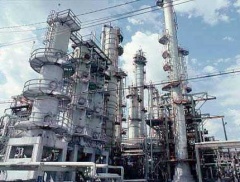Difference between revisions of "Cumene"
(→Risk factors) |
|||
| (7 intermediate revisions by the same user not shown) | |||
| Line 7: | Line 7: | ||
| risk factors = - | | risk factors = - | ||
}} | }} | ||
| + | __TOC__ | ||
==Description== | ==Description== | ||
Cumene (not be confused with cumin or cumulene). | Cumene (not be confused with cumin or cumulene). | ||
| Line 35: | Line 36: | ||
|Insoluble in water | |Insoluble in water | ||
|}<br> | |}<br> | ||
| + | Cumene is the common name for isopropylbenzene, an organic compound that is based on an aromatic hydrocarbon with an aliphatic substitution. It is a constituent of [[Crude Oil]] and refined fuels. It is a flammable colourless liquid that has a boiling point of 152 °C. Nearly all the cumene that is produced as a pure compound on an industrial scale is converted to cumene hydroperoxide, which is an intermediate in the synthesis of other industrially important [[chemicals]], primarily phenol and [[acetone]].<br><br> | ||
| + | Isopropylbenzene is stable, but may form peroxides in storage if in [[contact]] with the air. It is important to test for the presence of peroxides before heating or distilling. The chemical is also flammable and incompatible with strong oxidizing agents. Environmental laboratories commonly test isopropylbenzene using a Gas chromatography–mass spectrometry (GCMS) instrument.<br><br> | ||
| + | Commercial production of cumene is carried out through the catalytic alkylation of benzene, with the addition of propylene. Solid phosphoric acid (SPA) supported on [[alumina]] can also be used as a catalyst, and this was the case prior to the mid-1990's when zeolite-based catalysts made the other technique commercially redundant. This process is other wise known as Friedel-Crafts alkylation reaction.<br><br> | ||
| + | Isopropylbenzene is stable, but may form peroxides in storage if in [[contact]] with the air. It is important to test for the presence of peroxides before heating or distilling. The chemical is also flammable and incompatible with strong oxidizing agents. Environmental laboratories commonly test isopropylbenzene using a GCMS instrument.<br><br> | ||
| + | |||
| + | ==Application== | ||
| + | Fluorocarbon plastics, solvent, analytical chemistry, fumigant, insecticides.<br><br> | ||
| + | ==Risk factors== | ||
| + | Toxic by inhalation; anesthetic, pro-longed inhalation or ingestion may be fatal. TLV: 10 ppm in air, 50 mg/m<sup>3</sup> of air. OSHA PEL: 50 ppm for 10 minutes. A carcinogen. It has been prohibited by FDA from use in drugs, cosmetics and food packaging, including cough medicines, toothpastes, etc. Non flammable. Will burn on pro-longed exposure to flame or high temperature.<br><br> | ||
| + | <b>Check ISO Code and applicable MSDS sheets.</b><br> | ||
| + | |||
| + | [[Category: Products]][[Category: Oil and chemicals]] | ||
Latest revision as of 12:55, 11 April 2013
| Infobox on Cumene | |
|---|---|
| Example of Cumene |  |
| Facts | |
| Origin | - |
| Stowage factor (in m3/t) | - |
| Humidity / moisture | - |
| Ventilation | - |
| Risk factors | - |
Cumene
Description
Cumene (not be confused with cumin or cumulene).
| Appearance | Colorless liquid |
| Density | 0.862 g cm-3, liquid |
| Melding point | -96°C, 177 K, -141° F |
| Boiling point | 152°C, 425 K, 306°F |
| Main hazards | flammable |
| Flash point | 43°C |
| Insoluble in water |
Cumene is the common name for isopropylbenzene, an organic compound that is based on an aromatic hydrocarbon with an aliphatic substitution. It is a constituent of Crude Oil and refined fuels. It is a flammable colourless liquid that has a boiling point of 152 °C. Nearly all the cumene that is produced as a pure compound on an industrial scale is converted to cumene hydroperoxide, which is an intermediate in the synthesis of other industrially important chemicals, primarily phenol and acetone.
Isopropylbenzene is stable, but may form peroxides in storage if in contact with the air. It is important to test for the presence of peroxides before heating or distilling. The chemical is also flammable and incompatible with strong oxidizing agents. Environmental laboratories commonly test isopropylbenzene using a Gas chromatography–mass spectrometry (GCMS) instrument.
Commercial production of cumene is carried out through the catalytic alkylation of benzene, with the addition of propylene. Solid phosphoric acid (SPA) supported on alumina can also be used as a catalyst, and this was the case prior to the mid-1990's when zeolite-based catalysts made the other technique commercially redundant. This process is other wise known as Friedel-Crafts alkylation reaction.
Isopropylbenzene is stable, but may form peroxides in storage if in contact with the air. It is important to test for the presence of peroxides before heating or distilling. The chemical is also flammable and incompatible with strong oxidizing agents. Environmental laboratories commonly test isopropylbenzene using a GCMS instrument.
Application
Fluorocarbon plastics, solvent, analytical chemistry, fumigant, insecticides.
Risk factors
Toxic by inhalation; anesthetic, pro-longed inhalation or ingestion may be fatal. TLV: 10 ppm in air, 50 mg/m3 of air. OSHA PEL: 50 ppm for 10 minutes. A carcinogen. It has been prohibited by FDA from use in drugs, cosmetics and food packaging, including cough medicines, toothpastes, etc. Non flammable. Will burn on pro-longed exposure to flame or high temperature.
Check ISO Code and applicable MSDS sheets.











